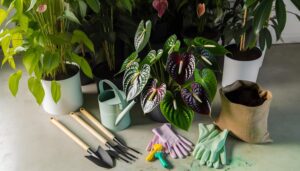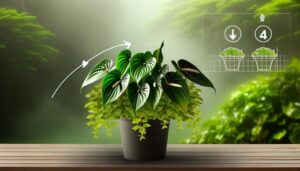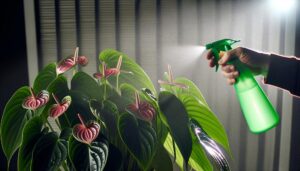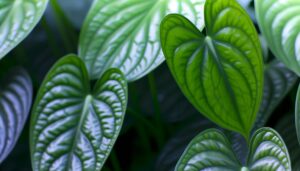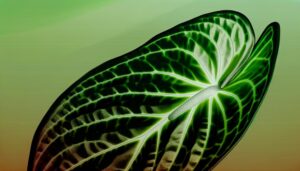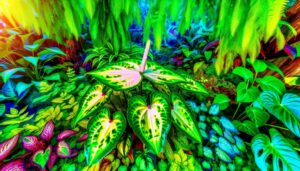Growing Anthurium X Andraeanum Cv: a Complete Guide
Cultivating Anthurium X Andraeanum Cv requires precise attention, starting with choosing terracotta pots with excellent drainage. Utilize a well-structured potting mixture of sphagnum peat moss, pine bark, and perlite for superior root health.
Maintain humidity levels using humidifiers or pebble trays, ensuring necessary transpiration rates. Apply balanced, water-soluble fertilizers rich in micronutrients.
Monitor and address common pests like aphids and mealybugs, and promptly deal with diseases such as bacterial blight. Pruning is essential for healthy morphology.
Accurate humidity and temperature regulation improve the ornamental quality. Keep exploring advanced techniques for thorough plant management.
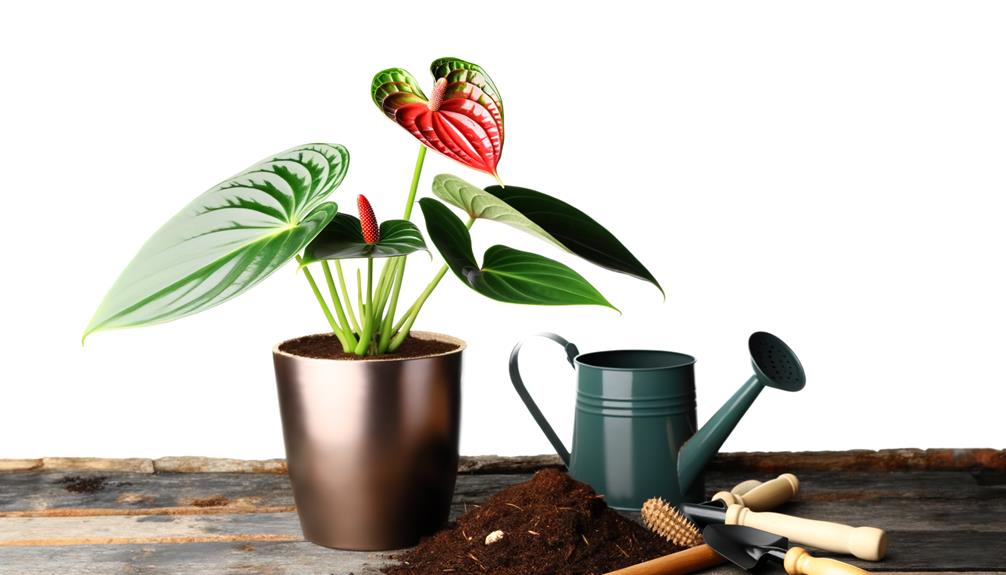
Key Takeaways
- Use terracotta pots with multiple drainage holes to prevent waterlogging and promote aeration.
- Create a potting mix with perlite, orchid bark, and sphagnum moss for optimal soil composition.
- Maintain humidity with humidifiers or pebble trays and ensure good air circulation to prevent fungal infections.
- Apply a balanced water-soluble fertilizer and monitor nutrient levels for healthy growth.
- Regularly prune to remove damaged foliage and watch for pests like aphids and spider mites.
Selecting the Right Pot
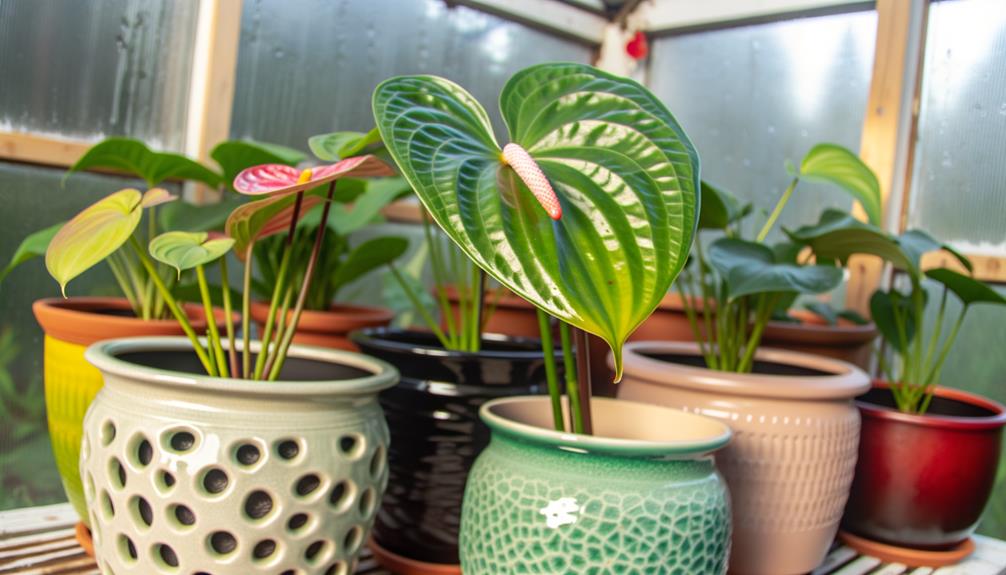
Selecting the right pot for Anthurium X Andraeanum Cv involves choosing a container that provides adequate drainage, appropriate size, and suitable material to support the plant's specific physiological needs.
Adequate drainage is essential; hence, pots with multiple drainage holes are preferred to prevent waterlogging and root rot. The pot size should correlate with the plant's root system, allowing for moderate growth without overwhelming space, typically 1-2 inches larger in diameter than the root ball.
Material selection, such as terracotta or ceramic, influences moisture retention and aeration. Terracotta pots offer porous surfaces enhancing breathability, vital for root health. Conversely, non-porous materials like plastic may retain more moisture, necessitating careful watering practices to avoid over-saturation.
Ideal Potting Mix
The best potting mix for Anthurium X Andraeanum Cv requires a balanced composition of components to guarantee sufficient drainage and aeration, vital for root health.
Including materials like perlite, orchid bark, and peat moss not only improves the soil structure but also offers necessary organic material that encourages nutrient retention and microbial activity.
This specialized mixture supports the epiphytic characteristics of Anthuriums, reducing the chances of root rot and promoting strong growth.
Proper Soil Composition
Achieving ideal growth for Anthurium X Andraeanum Cv requires using a potting mix that combines components guaranteeing sufficient aeration, moisture retention, and nutrient availability. An ideal potting mix typically comprises a blend of organic and inorganic materials to create a balanced environment. A common formulation includes sphagnum peat moss for moisture retention, pine bark for aeration, and perlite to improve drainage. These elements collectively maintain a balance between water retention and air space, essential for root health.
| Component | Function |
|---|---|
| Sphagnum Peat Moss | Moisture retention |
| Pine Bark | Aeration and structure |
| Perlite | Enhances drainage |
| Charcoal | Detoxifies and prevents odors |
This composition guarantees the necessary physical and chemical properties for optimal Anthurium X Andraeanum Cv development.
Drainage and Aeration
Proper drainage and aeration are essential for maintaining the health of Anthurium X Andraeanum Cv roots, preventing waterlogged conditions and facilitating gas exchange. A well-structured potting mix is critical for achieving these conditions.
Ideally, the mix should consist of coarse materials such as perlite, orchid bark, and coarse sand, which promote drainage by allowing water to percolate quickly. Additionally, incorporating sphagnum moss can enhance moisture retention while still allowing adequate airflow. The inclusion of charcoal helps to improve aeration and acts as a natural purifier, mitigating harmful pathogens.
An excellent potting medium should maintain a balance between moisture retention and drainage, ensuring that the root zone remains oxygenated and free from excess water accumulation.
Organic Matter Benefits
In addition to promoting drainage and aeration, incorporating organic matter into the potting mix of Anthurium X Andraeanum Cv enhances nutrient availability and supports beneficial microbial activity. Organic materials such as compost, peat moss, and coconut coir improve the cation exchange capacity (CEC), facilitating the retention and release of essential nutrients. Moreover, the organic matter fosters a microenvironment that benefits mycorrhizal fungi and nitrogen-fixing bacteria, which symbiotically enhance plant health. Below is a comparative table highlighting the benefits of different organic matter components:
| Organic Matter Component | Key Benefits |
|---|---|
| Compost | Nutrient-rich, improves CEC |
| Peat Moss | Retains moisture, acidic pH |
| Coconut Coir | Enhances aeration, sustainable |
| Bark Chips | Promotes drainage, durable |
These components collectively create an excellent growing medium for Anthurium X Andraeanum Cv.
Light Requirements
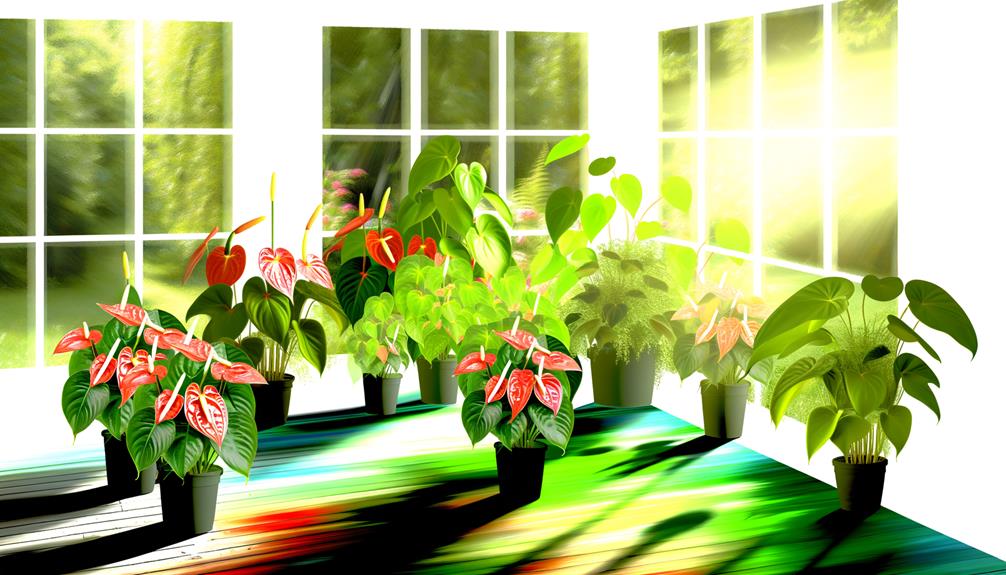
Understanding the light requirements for Anthurium X Andraeanum Cv is vital to optimize its growth and flowering potential.
This species thrives under bright, indirect light conditions, which mimic its natural habitat under the canopy of tropical rainforests.
It is imperative to avoid direct sunlight exposure, as it can cause photoinhibition and leaf burn, adversely affecting the plant's physiological processes.
Optimal Light Conditions
Achieving the finest growth for Anthurium x andraeanum cv requires careful management of light intensity, as these plants thrive under bright, indirect light conditions.
The most suitable light spectrum should range between 10,000 to 20,000 lux, which mimics the dappled sunlight of their native tropical understory.
Inadequate light can lead to etiolation, characterized by elongated stems and pale leaves, whereas excessively high light intensity may result in photoinhibition, causing leaf chlorosis and necrosis.
Utilizing light meters can accurately measure light levels, ensuring the plants receive sufficient yet non-harmful illumination.
Positioning Anthurium in east-facing windows or using artificial grow lights with a balanced spectrum can mitigate fluctuations in natural light, promoting consistent photomorphogenesis and vigorous growth.
Avoid Direct Sunlight
Direct sunlight exposure can lead to harmful effects such as leaf scorch and thermal stress in Anthurium x andraeanum cv, necessitating careful placement to guarantee only filtered or indirect light reaches the plant. This tropical species thrives under a light regime that mimics its native understory habitat.
Excessive direct sunlight can cause photodamage to the chlorophyll, resulting in chlorosis, necrosis, and stunted growth. Ideal positioning includes locations with bright, indirect light or dappled sunlight, such as under a sheer curtain or in a room with ample ambient light but away from windows with direct sun exposure.
Employing artificial grow lights with specific wavelengths can also be beneficial, provided they replicate the spectral quality of natural, diffused sunlight without the intensity.
Watering Techniques
Proper watering methods for Anthurium X Andraeanum Cv are crucial, as the species requires a carefully balanced moisture level to prevent root rot while ensuring sufficient hydration. Ideal irrigation involves maintaining consistently moist—but not waterlogged—soil. Utilize a well-draining substrate made of peat, pine bark, and perlite to facilitate proper water flow and aeration.
Watering frequency should be adjusted based on environmental conditions; typically, watering once a week suffices, but during periods of high transpiration rates, bi-weekly irrigation may be necessary. Use tepid water to avoid thermal shock and guarantee even soil saturation without overwatering.
Monitoring soil moisture with a hygrometer can help in achieving precise hydration levels, promoting vigorous growth and colorful inflorescences.
Temperature and Humidity
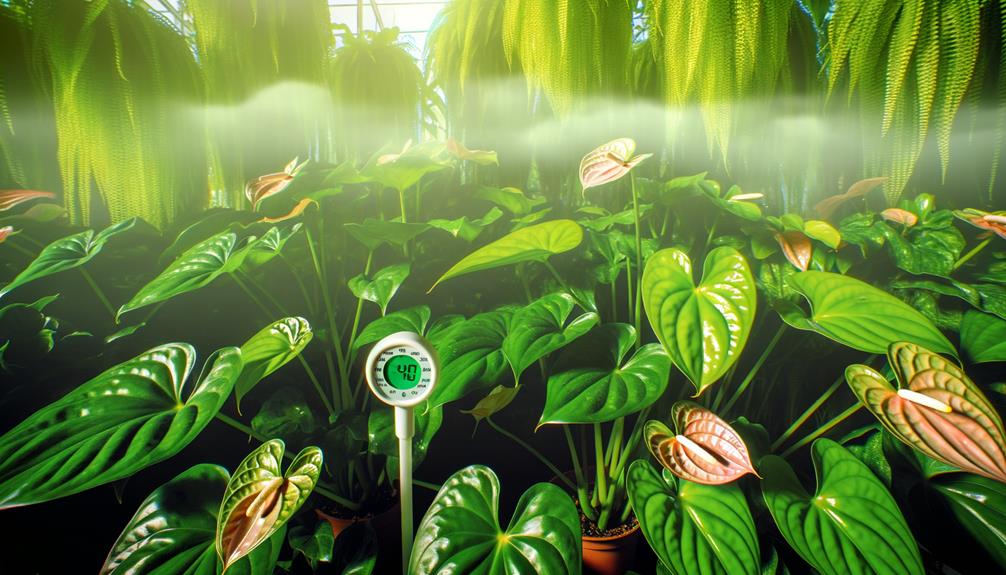
Best growth of Anthurium X Andraeanum Cv requires maintaining ambient temperatures between 70-85°F (21-29°C) and relative humidity levels around 70-80%. To achieve this, consistent monitoring of the microclimate is essential. Utilize hygrometers and thermostats to ensure ideal conditions.
Temperature fluctuations can induce stress, leading to suboptimal cellular functions and reduced photosynthetic efficiency. High humidity is vital for transpiration and nutrient uptake. In arid environments, employ humidifiers or pebble trays to elevate moisture levels. Additionally, guarantee adequate air circulation to prevent fungal infections while maintaining high humidity.
Integrating these environmental controls fosters robust growth and vibrant inflorescences, maximizing the ornamental value of Anthurium X Andraeanum Cv.
Fertilization Tips
Promoting top-notch nutrient availability, the application of a balanced, water-soluble fertilizer with a nitrogen-phosphorus-potassium (N-P-K) ratio of 20-20-20 is recommended for Anthurium X Andraeanum Cv. This formulation promotes robust vegetative growth, enhances root development, and supports peak flowering.
Administer the fertilizer biweekly during the active growing season, typically spring through early fall. Dilute the fertilizer to half-strength to prevent nutrient burn and support gradual nutrient uptake.
Additionally, incorporating micronutrients, such as iron, magnesium, and manganese, will address potential deficiencies and support overall plant health. To avoid salt buildup, periodically leach the soil by flushing with water.
Monitoring foliar and soil nutrient levels can further tailor fertilization practices, ensuring precise nutrient management for peak Anthurium health.
Common Pests and Diseases
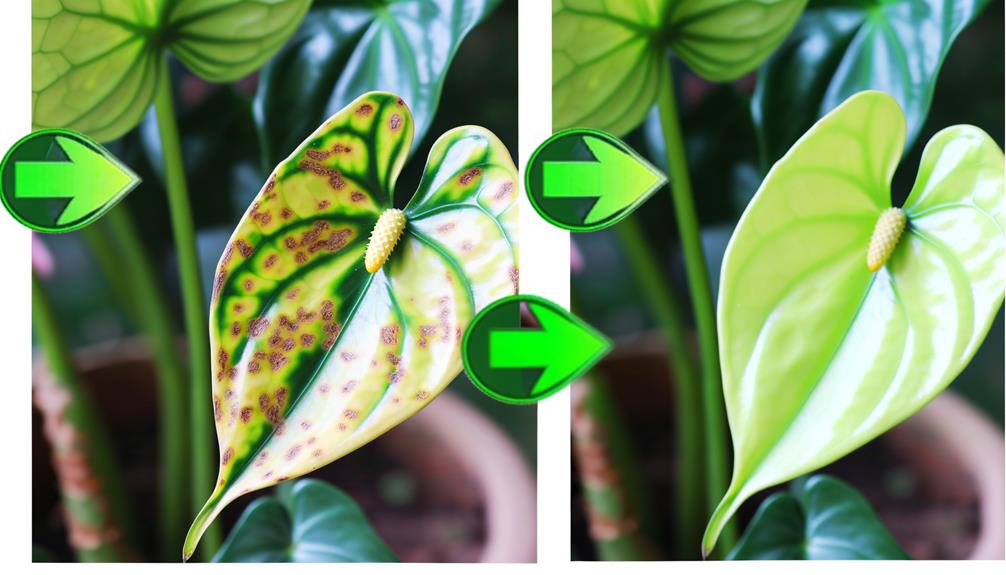
While ideal fertilization practices are essential for healthy growth, vigilance against common pests and diseases is equally important to maintaining the overall health and vigor of Anthurium X Andraeanum Cv.
Common pests include aphids (Aphidoidea), spider mites (Tetranychidae), and mealybugs (Pseudococcidae), which can cause chlorosis, stunted growth, and deformed leaves. Effective management involves regular monitoring and biological controls such as predatory insects.
Diseases such as bacterial blight (Xanthomonas axonopodis) and root rot (Pythium spp.) can lead to necrosis and systemic failure. Implementing proper sanitation, optimizing drainage, and employing fungicides are essential preventive measures.
Understanding these biotic stress factors is vital for sustaining the ornamental quality and longevity of Anthurium X Andraeanum Cv.
Pruning and Maintenance
Pruning and maintenance of Anthurium X Andraeanum Cv are crucial horticultural practices that promote ideal plant morphology, enhance aesthetic appeal, and prevent senescence by removing senescent, diseased, or damaged foliage.
Regular pruning facilitates optimal light penetration and air circulation, thereby mitigating fungal pathogens and pest infestations. Employ sterilized, sharp pruning shears to excise yellowing leaves and wilting inflorescences at their base to avoid pathogenic spread.
Additionally, periodic removal of dead organic matter from the substrate is crucial to maintain soil health. Adequate maintenance includes monitoring for nutrient deficiencies and implementing targeted fertilization regimes to sustain robust vegetative and reproductive growth.
This all-encompassing approach guarantees the Anthurium X Andraeanum Cv remains vigorous and visually enthralling throughout its lifecycle.
Conclusion
To sum up, cultivating Anthurium x andraeanum cv. requires careful handling of various factors. Best results are attained through the choice of appropriate containers and exact planting blends.
Sufficient light, water, and temperature conditions, along with suitable humidity levels, are crucial. Fertilization must be carried out prudently, while diligent monitoring for pests and diseases is vital.
Trimming practices should be done regularly to boost plant health. Following these specific guidelines guarantees prosperous and enduring growth of this beautiful species.

